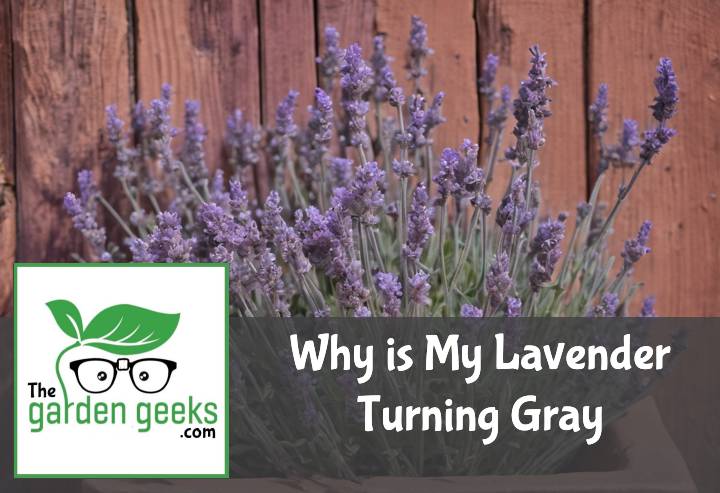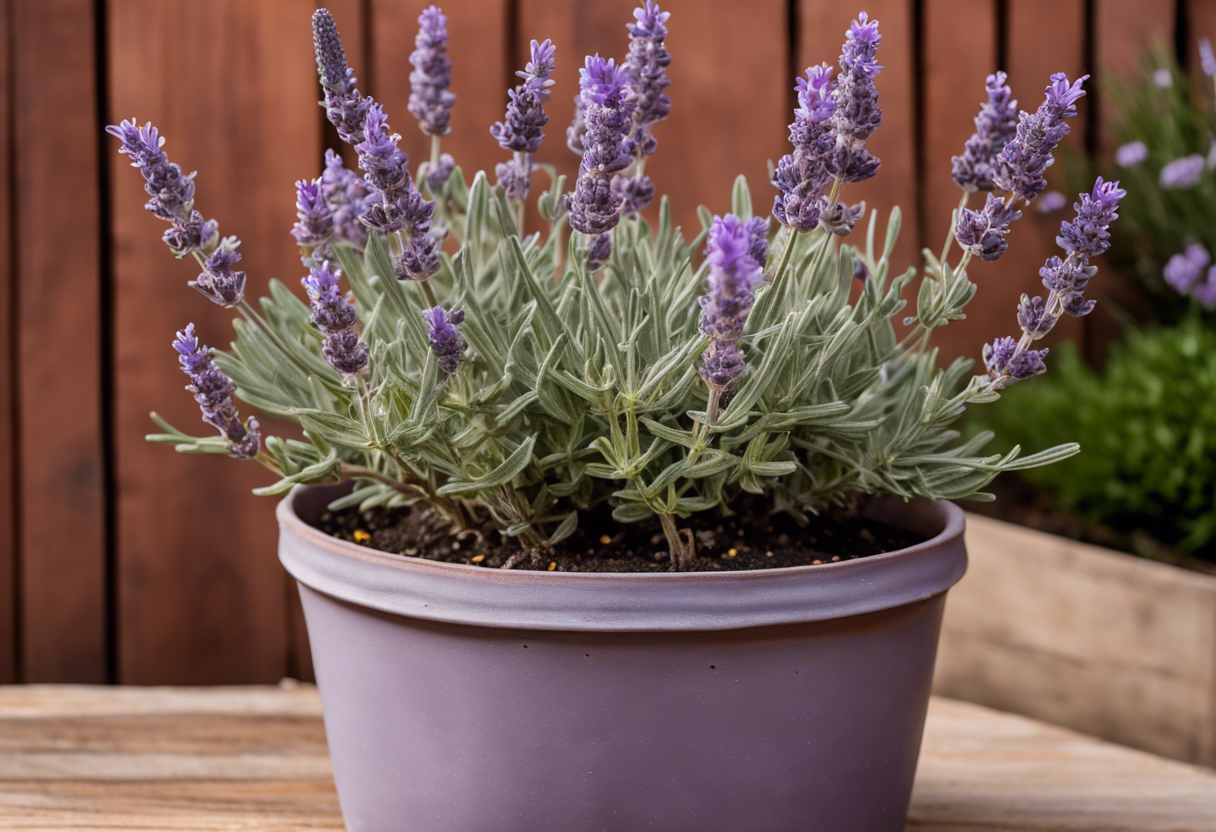“Hey there, green thumbs! Ever looked at your lavender plant and thought Why is My Lavender Turning Gray? Well, you’re not alone. It’s a common issue that many garden enthusiasts like us face. But don’t worry, it’s not always a death sentence for your beloved plant.”
“In the following sections, we’ll dive into why this happens and how to solve it. So keep those gardening gloves close by and let’s get to the root of the problem – pun totally intended! Keep reading about ‘Why is My Lavender Turning Gray? (How to Solve it)’.”
Key Takeaways
- Lavender turns gray due to overwatering, poor drainage, or fungal diseases like root rot and botrytis.
- To solve this, ensure the plant is watered sparingly and has well-draining soil.
- Prune infected parts to prevent spread of disease.
- Use fungicides if necessary.
- Consider replanting in a raised bed or pot for better drainage.
- Maintain good air circulation around the plant to prevent fungal growth.
Understanding Lavender Plants
Ah, the lovely lavender! Originating from the Mediterranean region, these beauties are known for their vibrant purple flowers and soothing scent. But hey, did you know that lavender plant characteristics can vary depending on the type? Yep, it’s true!
The Ideal Conditions for Lavender Growth
Now let’s talk about what makes these plants tick. Sunlight, soil, water – they’re all part of the equation. For starters, sunlight requirements for lavender are pretty high. These sun-loving plants need at least 6 hours of direct sunlight each day.
Moving onto soil, well-drained sandy or gravelly soils are the best buddies for your lavender. Best soil for lavender, you ask? Think light and airy with a neutral to slightly alkaline pH level.
And lastly, watering needs. Lavenders are drought-tolerant and overwatering is a big no-no! So remember folks – when it comes to watering lavender plants, less is more.
Common Varieties of Lavender and Their Specific Needs
Alrighty then! Now that we’ve covered the basics of lavender plant care, let’s dive into some common varieties.
First up is English Lavender. Known as the most fragrant variety, growing English Lavender requires cool winters and warm summers. It also prefers slightly acidic to neutral soil conditions.
Next on our list is French Lavender. This one’s a bit different – it can tolerate hotter climates and even thrives in poor quality soils! So if you’re looking for some easy-going greenery, these French Lavender care tips might just do the trick: full sun exposure and well-drained soil will keep them happy.
So there you have it folks! A quick guide to understanding why your beloved lavender might be turning gray. Remember – every plant has its own set of needs. So keep an eye out and happy gardening!
Why is My Lavender Turning Gray?
Well, why is my lavender turning gray? It’s a question that has puzzled many a gardener. The answer lies in understanding the nuances of lavender plant care and recognizing the signs of change. Let’s delve into some reasons behind this mysterious lavender color change.
Natural Aging Process of Lavender
First off, let’s talk about age. Just like us humans, lavenders go through an aging process too. Over time, these plants mature and their vibrant purple hue can fade to a silvery-gray. This is all part of the lavender life cycle.
The transformation isn’t overnight though! As your old lavender turns gray, it’s simply showing its age. It’s nothing to worry about really; it’s just nature doing its thing! Remember, the lifespan of lavender plants varies depending on their variety and growing conditions.
Impact of Weather Conditions on Lavender Color
Next up – weather conditions! They play a significant role in your lavender’s appearance. Cold temperatures can cause your lavender to turn grayish, especially if it’s not used to such chilly climates (lavender in cold weather).
On the other hand, excessive heat can also affect your plant’s coloration (heat effect on lavender color). Too much sunlight might bleach out the vibrant purple we all love so much (sunlight impact on lavender color). So remember folks, balance is key when it comes to weather!
Effects of Pests and Diseases on Lavender
Lastly, let’s not forget about those pesky pests and diseases. They’re no friends to our beloved lavenders! Certain bugs and illnesses can cause damage leading to a grayish hue (common pests for lavenders, diseases affecting lavenders).
If you notice any unusual spots or discoloration alongside the graying, it might be a sign of pest damage on lavenders. In such cases, it’s best to consult with a plant expert or do some online sleuthing to identify the culprit and find a solution.
How to Diagnose the Problem?
So, you’re asking yourself, “Why is My Lavender Turning Gray?” Well, let’s put on our detective hats and diagnose these lavender plant problems. We’ll be looking at potential disease or pest infestations, soil and watering conditions, as well as sunlight exposure and temperature. It’s time to start diagnosing lavender issues!
Checking for Signs of Disease or Pest Infestation
First things first, we need to check for signs of disease or pests. Now don’t panic! Your lavender isn’t necessarily doomed if it has a few bugs crawling around. But if you notice your plant looking a bit under the weather with yellowing leaves or wilting stems, it might be suffering from one of the common lavender diseases.
On the other hand, if you see tiny critters making themselves at home on your plant, that’s a clear sign of a pest infestation in lavenders. Some common culprits include aphids and whiteflies. So keep an eye out for these little troublemakers!
Assessing the Soil and Watering Conditions
Next up is checking out the soil and watering conditions. Lavenders are pretty low-maintenance plants but they do have their preferences when it comes to soil and water. They love well-drained soil – think sandy or gravelly types – so if your lavender is sitting in heavy clay-like soil, that could be part of the problem.
As for watering, lavenders aren’t big fans of wet feet! Overwatering can lead to root rot which is definitely not good news for your plant’s health. So make sure you’re following a proper watering schedule based on your local climate conditions.
Evaluating Sunlight Exposure and Temperature
Last but not least, let’s talk about sunlight exposure and temperature. Lavenders love basking in full sun – we’re talking at least 6 hours of sunlight a day. If your lavender is stuck in a shady corner, it might be feeling a bit deprived.
Temperature-wise, lavenders can handle the heat but they do struggle in extreme cold. So if you live in an area with harsh winters, make sure to give your lavender some extra protection or consider growing it indoors.
Solutions to Prevent Your Lavender from Turning Gray
Let’s dive into some lavender care tips that can help you prevent your lavender from turning gray. It’s all about the right watering techniques, sunlight exposure, and soil and fertilizer use. These are key in maintaining healthy lavenders and providing effective gray lavender prevention.
Proper Watering Techniques for Healthy Lavenders
Now, let’s talk water. You might be thinking, “It’s a plant! Of course it needs water!” But hold up there, cowboy. It’s not just about dumping a gallon of H2O on your lavender every day.
The trick is to find the Goldilocks zone of watering – not too much, not too little. This is crucial in preventing gray lavenders with water. Too much water can lead to root rot, while too little can cause dehydration.
So what’s the sweet spot? Well, it depends on your climate and soil type but generally speaking, once or twice a week should do the trick. Remember these healthy lavender watering habits, folks!
Ensuring Optimal Sunlight Exposure
Next up: sunlight. Your lavender loves basking in the sun almost as much as my cat does (and trust me, that’s saying something).
Adequate sunlight exposure is essential for preventing gray lavenders with sunlight. Without enough light, your plant may become weak and susceptible to diseases.
So how much sun are we talking here? Ideally, lavenders need at least six hours of direct sunlight each day for optimal growth and health. So make sure you’re giving your plants their daily dose of Vitamin D!
Using Appropriate Soil and Fertilizers
Last but definitely not least: soil and fertilizers. You wouldn’t eat junk food all day (well… hopefully), so why feed your plants with poor quality soil?
Choosing suitable soil and fertilizers is like providing your lavender with a balanced diet. It helps in preventing gray lavenders with soil and fertilizers.
The best soil for lavenders is well-draining with a neutral to slightly alkaline pH. As for fertilizers, a slow-release type applied in the spring should do the trick.
Remember, folks, why is my lavender turning gray often boils down to these three factors: water, sunlight, and soil. So take care of these, and you’ll have happy, healthy lavenders!
How to Revive a Grayed-Out Lavender Plant?
So, you’re asking yourself “Why is My Lavender Turning Gray?” Well, fear not! There are several ways to revive grayed-out lavender. Let’s dive into the nitty-gritty of lavender plant care and how to rejuvenate these beauties.
Pruning Techniques for Grayed-Out Lavenders
Pruning can be your best friend when it comes to grayed-out lavenders. It’s like giving your plant a fresh haircut, encouraging healthy growth. The best time for this? Early spring or late summer.
Now, onto the method. Start by removing dead or diseased branches. Then, trim back about one-third of the plant’s height. This will stimulate new growth and help restore its vibrant purple color.
Treating Diseases and Pest Infestations in Lavenders
Sometimes, your lavender may turn gray due to diseases or pesky pests. Identifying these culprits early can save your plant from turning into a gray ghost.
Common diseases include root rot and fungal infections, both of which can be treated with fungicides. As for pests, watch out for aphids and whiteflies – they’re not fans of insecticidal soap!
Remember: prevention is better than cure! Regularly check your plants and take action at the first sign of trouble.
Replanting or Transplanting Techniques if Necessary
If all else fails, it might be time to consider replanting or transplanting your lavender. This isn’t an admission of defeat – sometimes a change of scenery is just what a plant needs!
When should you do this? If your lavender has outgrown its pot or if the soil has become too compacted. And how? Carefully remove the plant from its current location, ensuring you get as much root as possible.
Then find a sunny spot with well-draining soil, dig a hole twice the size of the root ball, and place your lavender in it. Backfill with soil, water thoroughly, and voila – your lavender has a new lease on life!
To Wrap Up
So, we’ve had a blast digging into the mystery of Why is My Lavender Turning Gray. Just like solving a good ol’ whodunit, we discovered it could be due to water issues, sunlight deprivation or pest attacks.
Remember, your lavender isn’t just throwing a gray tantrum for no reason. Listen to it! Keep an eye on these culprits and your lavender will be back to its vibrant self in no time!





